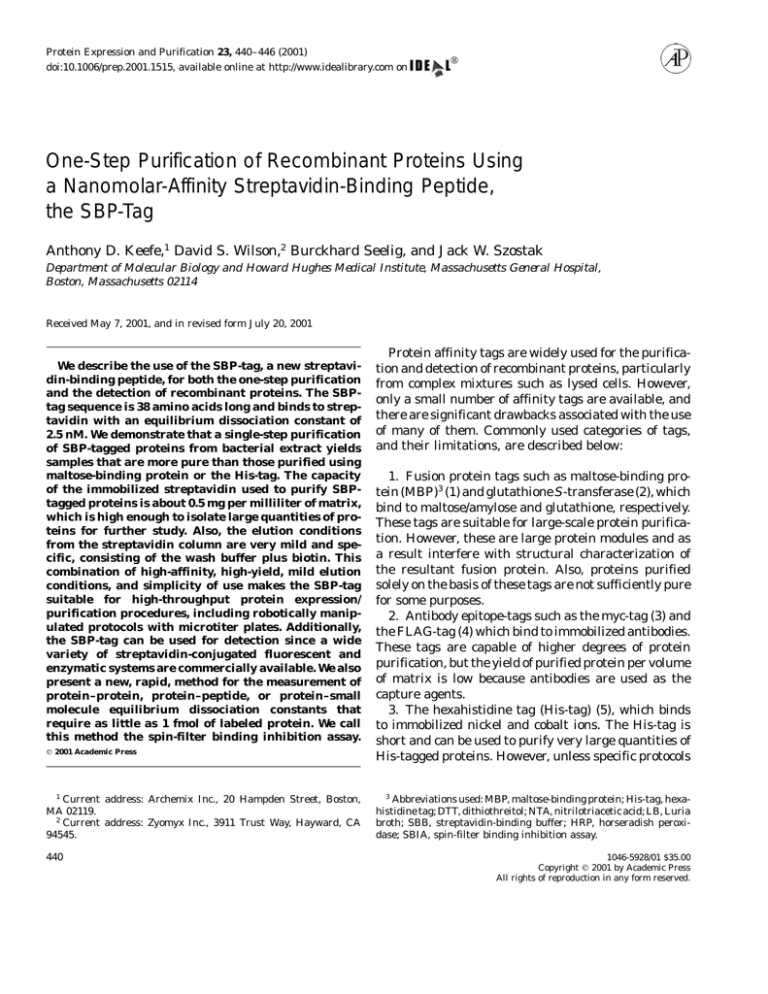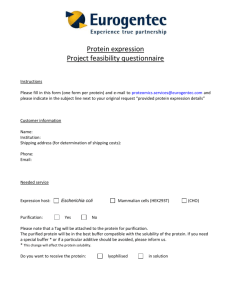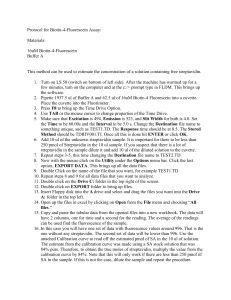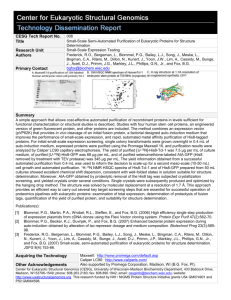One-Step Purification of Recombinant Proteins Using a Nanomolar-Affinity Streptavidin-Binding Peptide,
advertisement

Protein Expression and Purification 23, 440–446 (2001) doi:10.1006/prep.2001.1515, available online at http://www.idealibrary.com on One-Step Purification of Recombinant Proteins Using a Nanomolar-Affinity Streptavidin-Binding Peptide, the SBP-Tag Anthony D. Keefe,1 David S. Wilson,2 Burckhard Seelig, and Jack W. Szostak Department of Molecular Biology and Howard Hughes Medical Institute, Massachusetts General Hospital, Boston, Massachusetts 02114 Received May 7, 2001, and in revised form July 20, 2001 We describe the use of the SBP-tag, a new streptavidin-binding peptide, for both the one-step purification and the detection of recombinant proteins. The SBPtag sequence is 38 amino acids long and binds to streptavidin with an equilibrium dissociation constant of 2.5 nM. We demonstrate that a single-step purification of SBP-tagged proteins from bacterial extract yields samples that are more pure than those purified using maltose-binding protein or the His-tag. The capacity of the immobilized streptavidin used to purify SBPtagged proteins is about 0.5 mg per milliliter of matrix, which is high enough to isolate large quantities of proteins for further study. Also, the elution conditions from the streptavidin column are very mild and specific, consisting of the wash buffer plus biotin. This combination of high-affinity, high-yield, mild elution conditions, and simplicity of use makes the SBP-tag suitable for high-throughput protein expression/ purification procedures, including robotically manipulated protocols with microtiter plates. Additionally, the SBP-tag can be used for detection since a wide variety of streptavidin-conjugated fluorescent and enzymatic systems are commercially available. We also present a new, rapid, method for the measurement of protein–protein, protein–peptide, or protein–small molecule equilibrium dissociation constants that require as little as 1 fmol of labeled protein. We call this method the spin-filter binding inhibition assay. 䉷 2001 Academic Press 1 Current address: Archemix Inc., 20 Hampden Street, Boston, MA 02119. 2 Current address: Zyomyx Inc., 3911 Trust Way, Hayward, CA 94545. 440 Protein affinity tags are widely used for the purification and detection of recombinant proteins, particularly from complex mixtures such as lysed cells. However, only a small number of affinity tags are available, and there are significant drawbacks associated with the use of many of them. Commonly used categories of tags, and their limitations, are described below: 1. Fusion protein tags such as maltose-binding protein (MBP)3 (1) and glutathione S-transferase (2), which bind to maltose/amylose and glutathione, respectively. These tags are suitable for large-scale protein purification. However, these are large protein modules and as a result interfere with structural characterization of the resultant fusion protein. Also, proteins purified solely on the basis of these tags are not sufficiently pure for some purposes. 2. Antibody epitope-tags such as the myc-tag (3) and the FLAG-tag (4) which bind to immobilized antibodies. These tags are capable of higher degrees of protein purification, but the yield of purified protein per volume of matrix is low because antibodies are used as the capture agents. 3. The hexahistidine tag (His-tag) (5), which binds to immobilized nickel and cobalt ions. The His-tag is short and can be used to purify very large quantities of His-tagged proteins. However, unless specific protocols 3 Abbreviations used: MBP, maltose-binding protein; His-tag, hexahistidine tag; DTT, dithiothreitol; NTA, nitrilotriacetic acid; LB, Luria broth; SBB, streptavidin-binding buffer; HRP, horseradish peroxidase; SBIA, spin-filter binding inhibition assay. 1046-5928/01 $35.00 Copyright 䉷 2001 by Academic Press All rights of reproduction in any form reserved. STREPTAVIDIN-BINDING PEPTIDE TAG FOR PURIFYING PROTEINS are optimized for each protein, this tag does not completely remove contaminants. Also the His-tag is sometimes not an appropriate purification system if the activity of the protein of interest is compromised by immobilized ions or chelating groups. Some sources of expressed proteins, such as in vitro translation reactions from reticulocyte lysate, or EDTA-, EGTA-, or DTT-containing samples, cannot be purified using Ni– or Co–NTA without additional sample treatment. Irrespective of how useful the range of available protein affinity tags is, there is always a need for new tags that may be more suitable for the purification of a particular protein or under a particular set of conditions. A short streptavidin-binding peptide sequence called Strep-tag II was selected from random sequence (6–8) and has been used for both protein purification and detection. One important advantage of this peptide tag over the others listed above is that a wide variety of streptavidin-derivatized materials (plates, beads, enzymes, fluorophores, etc.) are commercially available. Also, because the Strep-tag II peptide can be selectively eluted from streptavidin by the addition of biotin, a high degree of purification can be achieved. The Streptag II–streptavidin interaction is, however, fairly weak (13 M (7)), which reduces its robustness as a generic purification tag. The affinity of this interaction has been improved, however, by an elegant set of experiments that identified a streptavidin mutant that binds the Strep-tag II with an affinity of about 1 M (9). We wanted to create a very robust, high-affinity streptavidin-binding peptide that could be used to purify proteins from complex mixtures, utilizing small amounts of immobilized streptavidin (such as the amount present on streptavidin-derivatized microtiter plate wells), and that could withstand extensive washing protocols. Accordingly we generated an ultrahigh complexity peptide library (diversity 7 ⫻ 1012 (10)) and used in vitro selection to identify peptide aptamers to immobilized streptavidin (11, 12). The use of one of these selected sequences as a protein affinity tag is reported here for the first time. We compare this tag to other high-affinity tags (maltose-binding protein and the His-tag) capable of supporting single-step purifications of milligram amounts of recombinant proteins. 441 nM, 1 mM extra MgCl2, and 100 mM extra KCl. This mixture was then purified successively upon the basis of the FLAG-tag and then the His-tag (using the manufacturer’s instructions; denaturing conditions were used for the Ni–NTA purification). The resultant purified peptide was then dialyzed into streptavidin-binding buffer (SBB, 300 mM KCl, 40 mM tris(hydroxymethyl)amino methane, 5 mM 2-mercaptoethanol, 2 mM EDTA, 0.1% Triton X-100, pH 7.4). The peptide was then diluted into the same buffer and mixed with a range of different streptavidin concentrations to give a set of 50-l samples in which the SB19-FLAG peptide was at 200 pM and the streptavidin concentration ranged from 30 pM to 1 M. Each of these samples was then incubated for 2 h at 0⬚C and then subsequently incubated for 1 min with 10-l samples of the washed and dried immobilized streptavidin matrix (Ultralink Immobilized Streptavidin Plus, Pierce, Rockford, IL). The flowthroughs are then immediately collected by centrifugation in a 0.2-m Durapore spin filter (Millipore, Bedford, MA) and these are counted in a scintillation counter. These data were iteratively fitted to the following equation y ⫽ b ⫹ c(KD/(KD ⫹ x)) in which y is the number of radioactive decompositions detected per minute in each flowthrough, KD is the dissociation constant of the complex, x is the concentration of free streptavidin, b is the number of counts per minute not competent to bind the matrix under the assay conditions, and c is the number of counts per minute competent to bind the matrix under the assay conditions. KD, b, and c were iteratively determined using the program Deltagraph 4.0 (SPSS, Chicago, IL). Expression of SBP-Tagged Proteins pTAG2K (Fig. 1), an expression vector encoding maltose-binding protein, the SBP-tag, and the His-tag, followed by a C-terminal insert, was prepared from pIADL14 (19) by restricting at the unique SalI and MATERIALS AND METHODS KD Determination of the SBP-Tag–Streptavidin Interaction The SB19-C4-FLAG (SBP-FLAG) peptide (12) was translated in the presence of 35S-labeled methionine by in vitro translation in reticulocyte lysate according to the manufacturer’s instructions (Red Nova, Novagen, Madison, WI) using a template concentration of 400 FIG. 1. Map of the pTAG2K vector indicating the order of the domains in the multiply-tagged fusion protein it encodes. 442 KEEFE ET AL. HindIII sites. BL21 (DE3) cells were transformed with a pTAG2K vector containing an insert of residues 22 to 67 of clone 18–19 from (16). Cultures were grown in LB at 37⬚C until the OD600 reached 1.6 and were then induced by the addition of 1 mM IPTG for 2 h. Cells were then centrifuged at 3000g for 20 min and the resultant pellets were resuspended in 5% of the original volume of a buffer appropriate for the subsequent affinity purification method. The samples were then frozen at ⫾20⬚C, thawed, and lysed by sonication until the resultant mixture appeared homogeneous. This lysate was then centrifuged at 14,000g for 20 min and the supernatant was applied directly to the appropriate affinity matrix. Purification upon the Basis of the SBP-Tag The soluble fraction of lysed induced cells (79 mg net weight cells in 1 ml SBB) was prepared as described above in SBB. This sample was applied directly to the immobilized streptavidin matrix (e.g., column volume 100 l; Ultralink Immobilized Streptavidin Plus, Pierce) and then incubated at 4⬚C for 30 min. The matrix was then washed with 40 column vol of SBB and then eluted with three successive 2 column vol aliquots of SBB containing 2 mM biotin for 10 min each. Samples of each of the lysed uninduced and lysed induced cells, the soluble fraction, and the elution fraction were then analyzed on an 8% SDS–Tricine–PAGE gel and then stained with Coomassie brilliant blue. In a typical experiment, 1 ml of the soluble fraction of lysed induced cells was loaded onto 0.1 ml of the affinity matrix. Purification upon the Basis of the His-Tag This purification was carried out in an analogous manner to the SBP-tag procedure with the same amounts of cells and in the same volumes. The soluble fraction was prepared in His-tag binding buffer (300 mM NaCl, 50 mM sodium phosphate, 0.25% Triton X100, 10 mM imidazole, pH 8.0). The sample was applied directly to the Ni column (Ni–NTA, Qiagen, Valencia, CA) and then incubated at 4⬚C for 30 min. The matrix was then washed with 40 column vol of the same buffer containing 20 mM imidazole and then eluted with three successive 2 column vol aliquots of the same buffer containing 250 mM imidazole for 10 min each. Samples were analyzed as described above. Purification upon the Basis of the Maltose-Binding Protein Sequence This purification was carried out in an analogous manner to the SBP-tag procedure with the same amounts of cells and in the same volumes. The soluble fraction was prepared in maltose-binding protein binding buffer (200 mM KCl, 20 mM Hepes, 10 mM 2-mercaptoethanol, 0.25% Triton X-100, pH 7.4). The sample was applied directly to the amylose column (New England Biolabs, Beverly, MA) and then incubated at 4⬚C for 30 min. The matrix was then washed with 40 column vol of the same buffer and then eluted with three successive 2 column vol aliquots of the same buffer containing 10 mM maltose for 10 min each. Samples were analyzed as described above. Detection of SBP-Tagged Protein with StreptavidinDerivatized Horseradish Peroxidase Ten picomoles of the pTAG2K-derived multiply tagged protein containing residues 22 to 67 of clone 18–19 from (16) in SDS–PAGE protein-loading buffer was loaded onto a 12% SDS–Tricine PAGE gel. In the adjacent lane, a whole bacterial extract from BL21 (DE3) cells was loaded. The whole cell extract was prepared by growing the cells to saturation in LB, removing the medium by centrifugation, and resuspending them in 10% of the original culture volume with the SDS– PAGE protein-loading buffer. Six microliters of this extract was run on the gel. These two samples and a molecular weight marker were run side by side on the gel in duplicate. After running the gel, it was cut in half, and one-half was stained with Coomassie brilliant blue and the other half was transferred to nitrocellulose (Trans-blot transfer medium, 0.2 m, Bio-Rad Cat. No. 162-0112) at 10 V for 30 min using the manufacturer’s instructions (Trans-blot semidry transfer cell, Bio-Rad Cat. No. 170-3940). Efficient protein transfer was confirmed by the presence of the prestained molecular weight markers on the nitrocellulose. After transfer, the nitrocellulose was incubated in TBS (25 mM Tris– HCl, 138 mM NaCl, 2.68 mM KCl, pH 7.4) plus 0.05% polyoxyethylene–sorbitan monolaurate (Tween 20) and 3% BSA for 1 h at room temperature. The blot was then briefly rinsed with the same buffer without BSA, and then a streptavidin-derivatized horseradish peroxidase conjugate (Amersham-Pharmacia, Product No. RPN1231) was added at a 1000-fold dilution in TBS/ 0.05% Tween-20/3% BSA, and allowed to incubate for 1 h at room temperature. The blot was then washed three times with TBS/0.05% Tween 20 and then one time with TBS. The HRP substrate (3,3⬘,5,5⬘-tetramethylbenzidene, Promega Cat. No. W4121) was then added according to the manufacturer’s instructions, and the blot was developed for approximately 1 min. RESULTS AND DISCUSSION Streptavidin-Binding Peptide Tag Sequence We previously (12) selected a streptavidin-binding sequence, SB19, from a peptide library containing 88 contiguous random amino acids (10) using an in vitro selection technique called mRNA display (13–16). Nand C-terminal deletion mutants defined a 38 amino STREPTAVIDIN-BINDING PEPTIDE TAG FOR PURIFYING PROTEINS FIG. 2. KD determination of the SBP-tag–streptavidin interaction using the spin-filter binding inhibition assay (SBIA). The labeled SBP-tagged peptide was incubated with a range of streptavidin concentrations and the amount not complexed was then determined after a short incubation with immobilized streptavidin (see Materials and Methods). This analysis gave a KD of 2.5 nM for the interaction of the SBP-tag sequence with streptavidin. acid long sequence, SB19-C4, that completely retained the binding activity of the longer peptide. Even shorter deletion mutants retain reduced streptavidin-binding activity and might also prove to be useful purification tags. The SB19-C4 peptide can be eluted from streptavidin by the addition of biotin. The sequence of the SB19C4 purification tag used in this paper, hereafter referred to as the SBP-tag, is MDEKTTGWRGGHVVEGLAGELEQLRARLEHHPQGQREP. Affinity of the SBP-Tag for Streptavidin Before attempting to use the SBP-tag–streptavidin interaction for purification purposes, we decided to measure the equilibrium dissociation constant (KD) of the complex. We previously (12) obtained a KD value of 2.4 nM using a streptavidin-derivatized microtiterplate-based assay, but we wanted to use a more general method not reliant upon the existence of appropriately functionalized microtiter plates. We have therefore developed an alternative method for measuring KD values, which we call the spin-filter binding inhibition assay (SBIA). This method is especially appropriate for cases in which numerous proteins or peptides are derived from in vitro selection techniques using immobilized targets such as phage display (17), mRNA display (13– 16), or ribosome display (18). The principal benefit of this method is that it allows the affinities and specificities of interacting proteins to be assayed before investing the time required to overexpress and purify them in the quantities required for conventional affinity determinations. SBIA utilizes low concentrations (⬍KD) of 35S-labeled 443 protein generated in a cell-free translation system. The labeled protein is exposed to the bead-immobilized target (in this case immobilized streptavidin), and then the flowthrough is collected by centrifugation in a 0.2m Durapore spin filter. The fraction of counts that pass through the filter (and therefore did not bind to the column) indicates the fraction of labeled peptide that did not bind to the matrix. To determine the affinity of the interaction, the labeled protein is first exposed to a range of concentrations of nonimmobilized target. After this mixture has reached equilibrium, it is briefly (1 min) exposed to the bead-immobilized target, and then spin filtered as above. The initial incubation with the soluble target will compete with the binding of the radiolabeled protein to the immobilized target. The amount of inhibition is directly related to the fraction of labeled protein that was bound to the free target before this mixture was exposed to the immobilized target. By plotting the immobilized target-binding inhibition against the concentration of the free target, the KD can easily be derived. Because this titration is based on the interaction of the protein with the free (not immobilized) target, it may be more accurate than methods that quantify peptide binding to immobilized targets. However, SBIA may underestimate the affinity if there is significant dissociation of the complex during the brief incubation with immobilized target. The KD corresponds to the concentration of free target that half-inhibits the binding to the immobilized target. As long as the concentration of the labeled binder is significantly lower than the KD, the concentration of free target may be approximated as the total concentration of added target. It is hoped that this method will be of general utility for the determination of KD values for protein–protein, protein–peptide, and protein–small molecule complexes. The binding of labeled SBP-tagged peptide is inhibited by preincubation with free streptavidin (Fig. 2). In this experiment 48% of the counts bound to immobilized streptavidin in the 1-min slurry incubation in the absence of free streptavidin competitor, and this binding was completely inhibited by high concentrations (⬎100 nM) of streptavidin. Analysis of the binding curve gives a KD of 2.5 nM, which compares very favorably with the KD determined by other methods (2.4 nM (12)). The SBP-tag therefore binds to streptavidin with a ⬃5000fold higher affinity than does the Strep-tag II (7). This higher affinity accounts for the fact that, after extensive washing (with 80 column vol), the yield of retained peptide using the SBP-tag was 2200-fold higher than the yield using the Strep-tag II (12). Both the SBP-tag and the Strep-tag II contain the tripeptide motif HPQ, but the flanking sequence in the SBP-tag presumably provides additional favorable contacts with streptavidin. We therefore decided to compare the SBP-tag to 444 KEEFE ET AL. other high-affinity tags commonly used in protein purification. Purity In order to assess the specificity of the interaction of the SBP-tag with immobilized streptavidin, a recombinant protein containing the SBP-tag, the His-tag, and MBP (see Fig. 1) was overexpressed in E. coli. Expression of this protein was induced, cells were lysed, and then the soluble portion of the lysate was incubated separately with immobilized streptavidin, Ni–NTA agarose, and beaded amylose columns. These columns were then washed extensively and the recombinant proteins were specifically eluted by the addition of biotin (in the case of the immobilized streptavidin), imidazole (in the case of Ni–NTA agarose), or maltose (in the case of beaded amylose). Figure 3 shows a Coomassie brilliant blue-stained SDS–Tricine–PAGE gel of the loaded and eluted samples from these procedures. A band of the correct size was purified using all three of these columns. Purification on immobilized streptavidin gave the highest purity sample, with no other bands visible by Coomassie brilliant blue-stained SDS– Tricine–PAGE gel analysis. At least one impurity could be detected from the Ni–NTA-purified sample, and several contaminants are apparent from the amylose-purified sample. These results suggest that the SBP-tag may provide superior purity after a single purification step from lysed induced cells. Yield When scaling-up protein expression to 1 mg and above, the capacity and expense of the affinity matrix may begin to become important. To measure the capacity of the three matrices for their respective tag sequences, we overloaded each matrix with the multiply-tagged protein described above. Cells overexpressing this protein were split into three aliquots and resuspended in different buffers according to the matrix that was to be used. The sample applied to immobilized streptavidin was extracted into streptavidinbinding buffer, and the samples for the other two purifications were extracted into the buffers recommended by the manufacturers of the two matrices (see Materials and Methods). The amount of protein in the flowthroughs, washes, and elution fractions was measured using the Bradford assay. We confirmed that each column was overloaded by observing the multiplytagged protein in the flowthrough fractions from each column. Purification using Ni–NTA agarose (His-tag/ imidazole) yielded 12 mg of protein per milliliter of matrix. The amylose column yielded 4.4 mg of protein per milliliter of matrix. The immobilized streptavidin column yielded 0.5 mg of protein per milliliter of matrix (0.53 mg/ml with a standard deviation of 0.07 mg/ml, n ⫽ 4). The overall capacity of immobilized streptavidin for the SBP-tag is therefore lower than that of the Ni– NTA agarose or amylose matrices for their respective tags, but significantly greater than that of immobilized antibody matrices for purifying proteins upon the basis of epitope tags. Detection of SBP-Tagged Proteins with StreptavidinDerivatized Reagents FIG. 3. Purity assay for a single-step purification of SBP-tagged (multiply-tagged) protein from lysed cells. Purity is compared to samples processed upon the basis of the His-tag or the maltose-binding protein sequences contained in the same protein. Lanes 1 and 2, lysed E. coli prior to and after IPTG induction, respectively. Lane 3, the soluble fraction of E. coli lysate in streptavidin-binding buffer. Lanes 4 through 6, approximately equal amounts of purified proteins from the elution fractions of the SBP-tag purification, the His-tag purification, and the MBP purification, respectively. Recombinant proteins containing affinity tags may be probed with reagents that bind to these affinity tags. A wide range of streptavidin-derivatized reagents is commercially available, and as a consequence the SBPtag could become a versatile detection tool. In order to demonstrate the utility of this interaction, we performed an experiment in which a recombinant protein was probed with streptavidin-derivatized horseradish peroxidase. We electrophoresed the purified SBPtagged protein (the multiply-tagged protein used above) and an E. coli cell lysate in adjacent lanes of a SDS– Tricine–PAGE gel. This gel was then stained with Coomassie brilliant blue to show all of the proteins in the samples. In an equivalent but unstained gel, the bands were transferred to nitrocellulose, incubated with STREPTAVIDIN-BINDING PEPTIDE TAG FOR PURIFYING PROTEINS 445 FIG. 4. Detection of a SBP-tagged protein with streptavidin-derivatized horseradish peroxidase. The left-hand panel shows the Coomassie brilliant blue staining of an SDS–Tricine–PAGE gel of the purified SBP-tagged (multiply tagged) protein and an E. coli extract. These same samples were also run on a different portion of the same gel and then transferred to a nitrocellulose membrane. The right-hand panel shows the result of the probing of this membrane with streptavidin-derivatized horseradish peroxidase. The only observed signal is for the SBPtagged protein, with no staining of proteins in the E. coli extract. streptavidin-derivatized horseradish peroxidase, and then visualized by incubation with the horseradish peroxidase substrate, 3,3⬘,5,5⬘-tetramethylbenzidene. These results are shown in Fig. 4. The SBP-tagged protein is readily observed, and no proteins from the E. coli lysate are labeled, thus indicating the specificity of this interaction. Streptavidin-derivatized horseradish peroxidase and other streptavidin-derivatized reagents should enable many useful methods of detecting SBP-tagged proteins on membranes, plates, tissue sections, etc. CONCLUSION The SBP-tag sequence can be used for the high-yield and high-purity single-step purifications of recombinant proteins expressed in E. coli and, presumably, other expression systems. The high affinity of the peptide for streptavidin (KD ⫽ 2.5 nM) means that, once bound to immobilized streptavidin, the column can be washed extensively. The specific and gentle nature of elution by the addition of biotin results in a highly purified protein sample. The capacity of the streptavidin matrix (0.5 mg recombinant protein per milliliter of immobilized streptavidin) is considerably higher than that of immobilized antibody-based matrices, but lower than matrices for purifying maltose-binding protein, glutathione S-transferase, or His-tagged proteins. The SBP-tag (38 amino acids) is much smaller than maltosebinding protein or glutathione S-transferase, but larger than the His-tag and most antibody epitopes. The main advantage of the SBP-tag will be when intermediate amounts of protein (⬃10–500 g) need to be produced and purified in a high-throughput manner. For example, highly parallel purification protocols could be performed in 96-well plates using streptavidin-derivatized magnetic beads and SBP-tagged proteins expressed in E. coli or in coupled in vitro transcription/translation reactions. This could be very useful for proteomics applications in which thousands of purified proteins need to be generated and purified in parallel. Furthermore, the nanomolar-affinity of the SBP-tag–streptavidin interaction affords a highly sensitive method for the detection of recombinant proteins and their interactions 446 KEEFE ET AL. with other molecules. We hope that the SBP-tag will constitute a useful addition to the growing list of affinity tags useful for the purification of recombinant proteins. We have also described a new method for the measurement of equilibrium dissociation constants (KD) that we have called the SBIA. SBIA does not require the expression of the protein in vivo and it is hoped that this method will be of general utility for the determination of KD values for other protein–protein, protein–peptide, and protein–small molecule complexes. ACKNOWLEDGMENTS We thank members of the Szostak lab, especially Glenn Short and Glen Cho, for advice and Pamela Svec for minipreps. J.W.S. is an investigator of the Howard Hughes Medical Institute; additional funding was provided by the Cancer Research Fund of the Damon Runyon–Walter Winchell Foundation, the Emmy Noether Program of the Deutsche Forschungsgesellschaft, the NASA Astrobiology Institute, and the NIH. The GenBank accession number of pTAG2K with an insert encoding amino acids 22 to 67 of clone 18–19 from (16) (the multiply-tagged protein) is AY033554. REFERENCES 1. Kellerman, O. K., and Ferenci, T. (1982) Maltose-binding protein from Escherichia coli. Methods Enzymol. 90, 459–463. 2. Smith, D. B., and Johnson, K. S. (1988) Single-step purification of polypeptides expressed in Escherichia coli as fusions with glutathione S-transferase. Gene 67, 31–40. 3. Evan, G. I., Lewis, G. K., Ramsay, G., and Bishop, J. M. (1985) Isolation of monoclonal antibodies specific for human c-myc protooncogene product. Mol. Cell Biol. 12, 3610–3616. 4. Brizzard, B. L., Chubet, R. G., and Vizard, D. L. (1994) Immunoaffinity purification of FLAG epitope-tagged bacterial alkaline phosphatase using a novel monoclonal antibody and peptide elution. Biotechniques 16, 730–735. 5. Janknecht, R., de Martynoff, G., Lou, J., Hipskind, R. A., Nordheim, A., and Stunnenberg, H. G. (1991) Rapid and efficient purification of native histidine-tagged protein expressed by recombinant vaccinia virus. Proc. Natl. Acad. Sci. USA 88, 8972– 8976. 6. Schmidt, G. M., and Skerra, A. (1993) The random peptide library-assisted engineering of a C-terminal affinity peptide, useful for the detection and purification of a functional Ig Fv fragment. Protein Eng. 6, 109–122. 7. Schmidt, G. M., Koepke, J., Frank, R., and Skerra, A. (1996) Molecular interaction between the Strep-tag affinity peptide and its cognate target, streptavidin. J. Mol. Biol. 255, 753–766. 8. Katz, B. A. (1999) Streptavidin-binding and -dimerizing ligands discovered by phage display, topochemistry, and structure-based design. Biomol. Eng. 16, 57–65. 9. Voss, S., and Skerra, A. (1997) Mutagenesis of a flexible loop in streptavidin leads to higher affinity for the Strep-tag II peptide and improved performance in recombinant protein purification. Protein. Eng. 10, 975–982. 10. Cho, G., Keefe, A. D., Liu, R. Wilson, D. S., and Szostak, J. W. (2000) Constructing high complexity synthetic libraries of long ORFs using in vitro selection. J. Mol. Biol. 297, 309–319. 11. Wilson, D. S., Keefe, A. D., and Szostak, J. W. (2000) “Streptavidin-Binding Peptides for Use in Protein Purification,” pending provisional patent, U.S. Serial No. 60/244541. 12. Wilson, D. S., Keefe, A. D., and Szostak, J. W. (2001) The use of mRNA display to select high-affinity protein-binding peptides. Proc. Natl. Acad. Sci. USA 98, 3750–3755. 13. Roberts, R. W., and Szostak, J. W. (1997) RNA–peptide fusions for the in vitro selection of peptides and proteins. Proc. Natl. Acad. Sci. USA 94, 12297–12302. 14. Liu, R., Barrick, J., Szostak, J. W., and Roberts, R. W. (2000) Optimized synthesis of RNA-protein fusions for in vitro protein selection. Methods Enzymol. 318, 268–293. 15. Keefe, A. D. (2001) Protein selection using mRNA display in “Current Protocols in Molecular Biology” (Ausubel, F. M., Brent, R., Kingston, R. E., Moore, D. D., Seidman, J. G., Smith, J. A., and Struhl, K.,” Unit 24.5, Wiley, New York. 16. Keefe, A. D., and Szostak, J. W. (2001) Functional proteins from a random-sequence library. Nature 410, 715–718. 17. Smith, G. P., and Petrenko, V. A. (1997) Phage display. Chem. Rev. 97, 391–410. 18. Jermutus, L., Ryabova, L., and Plückthun, A. (1998) Recent advances in producing and selecting functional proteins by using cell-free translation. Curr. Opin. Biotechnol. 9, 391–410. 19. McCafferty, D. G., Lessard, I. A. D., and Walsh, C. T. (1997) Mutational analysis of potential zinc-binding residues in the active site of the enterococcal D-Ala-D-Ala dipeptidase VanX. Biochemistry 36, 10498–10505.






